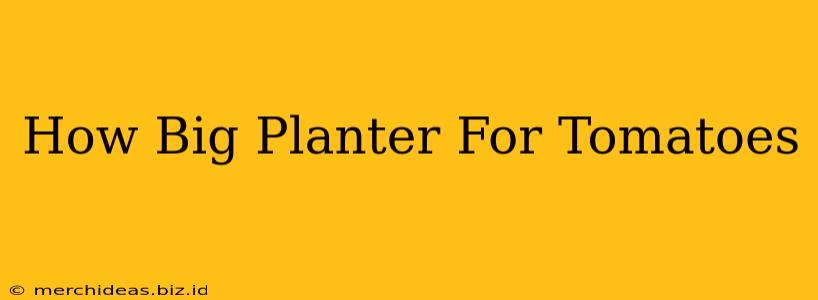Choosing the right size planter for your tomatoes is crucial for a bountiful harvest. Undersized containers restrict root growth, leading to smaller plants and fewer fruits. Let's explore the ideal planter size for healthy, productive tomato plants.
Factors Affecting Planter Size
Several factors influence the necessary size of your tomato planter:
1. Tomato Variety:
- Determinate Tomatoes: These compact varieties reach a certain height and then stop growing. They generally require smaller planters, around 5-7 gallons.
- Indeterminate Tomatoes: These vigorous vines grow continuously throughout the season, requiring significantly larger containers. Aim for planters holding at least 15-20 gallons, ideally even larger, for optimal growth.
2. Plant Maturity:
Young tomato seedlings can thrive in smaller pots initially. However, as they mature, they'll need to be transplanted into larger containers to accommodate their expanding root systems. Don't hesitate to upgrade your planter size as your plants grow larger.
3. Planter Material:
The material of your planter influences its effective size. Dark-colored containers absorb more heat, which can be beneficial in cooler climates but may lead to overheating in hot weather. Porous materials like terracotta dry out faster, requiring more frequent watering.
4. Growing Environment:
The climate where you grow your tomatoes affects the planter size needed. Hot, dry climates may benefit from larger containers to retain moisture. Conversely, in cooler areas, smaller containers might suffice.
Recommended Planter Sizes
Here's a general guideline for planter sizes based on tomato type:
- Small Determinate Tomatoes: 5-7 gallon containers
- Large Determinate Tomatoes: 7-10 gallon containers
- Small Indeterminate Tomatoes: 10-15 gallon containers
- Large Indeterminate Tomatoes: 15-20+ gallon containers (consider even larger for exceptionally vigorous varieties)
Choosing the Right Planter: Beyond Size
While size is important, consider these additional factors when selecting your tomato planter:
- Drainage: Excellent drainage is essential to prevent root rot. Ensure your container has ample drainage holes.
- Material: Choose a material suitable for your climate and watering habits.
- Depth: Sufficient depth is vital for proper root development. Aim for at least 12 inches of depth for most tomato varieties.
- Shape: While round planters are common, square or rectangular containers can offer greater root space for the same volume.
Troubleshooting Small Planters:
If you're using a smaller planter than recommended, you'll need to pay close attention to watering and fertilization. Frequent watering may be necessary to prevent the soil from drying out too quickly. Regular fertilization will also be important to supplement the limited nutrient supply available in a smaller volume of soil.
In Conclusion: Selecting the appropriately sized planter is an essential step in successfully growing tomatoes. By considering the factors mentioned above, you can provide your tomato plants with the space they need to thrive and produce a bountiful harvest. Remember to always prioritize good drainage and choose a container that allows for easy access for watering and harvesting.
